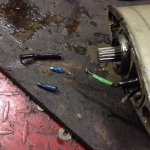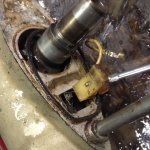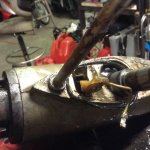you guys will get a kick out of this.... especially considering the recent "wire connector of choice" conversation!
I took of the lower unit gearcase off the engine, and didnt see any damage to the wires leading to the "bullet shaped" bit. All looked good, so I decided to take off the lowermost bullet part. Heeding F_R's advice, I loosened the two big studs (was easy, minimal corrosion) and carefully separated the bullet from the LU with a screwdriver. I only saw one wire and it had plenty of slack, so I continued to separate. Got it apart, and realized it was another one of those "knife" style connectors. I peeled the rubber back, un-knifed them, and pulled the bullet away from the rest of the LU.... cool, i thought...
then i realized there's another wire in there! Duh! but I swear, it wasnt me that broke it. Somebody's been in here before! The blue wire has been "repaired" at some point with a classic auto style bullet connector. we all know those have the potential to suck greatly. if some bozo puts them on wrong, they'll come right off the wire when you go to disconnect them. SO its possible I pulled the connectors right off the wire when I separated the bullet part, but I was very careful to peer into the crack between the cases to be careful about the wires. I only ever saw one that was connected. I have to expect the blue one was already disconnected. How/why is the next question.
If you look where the wires enter the bullet casing, there's a whitish/yellow piece of plastic, and a piece of metal just below it. Its a little garbled up/out of place if you ask me. I think the blue wire is connected to that, and that might have got sucked into someting/chomped up by a gear somehow?
I guess I need to keep dismantling this gearcase entirely, and see what the wire situation is in there. Once I can get at the leads, I can take resistance measurements at the coils proper and see if they are still ok. Hoping they are, in which case I just need to repair the wires that connect to them. F_R mentioned I would not be able to solder anything back on, which may be true, but I'm sure I can come up with a mechanical means with which to fasten the wires back together in a semi-permanent fashion. We shall see.....
























